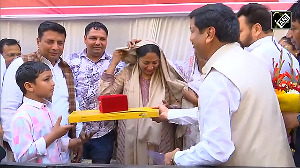The main revenue for retail payments currently lies in commissions on Direct Benefits Transfer (DBT) payments, which have been mired in confusion and unpredictability, says SV Divvaakar.
 While the Pradhan Mantri Jan Dhan Yojana (PMJDY) has chalked up significant achievements in opening bank accounts, the focus moves now to transactions and account activity.
While the Pradhan Mantri Jan Dhan Yojana (PMJDY) has chalked up significant achievements in opening bank accounts, the focus moves now to transactions and account activity.
Here, the key driver will be the Direct Benefits Transfers (DBT) payment flows from government to banks to customer accounts, and thereon to customers as cash withdrawals or as digital transactions.
The DBT pilot experience reveals that the first part, getting the credits into the bank account, is easy, and depends on mapping the beneficiary's Aadhaar number to the nominated bank account, an exercise that has been substantially completed.
It is the latter part, of cash withdrawals or conducting digital transactions (remittances, utility payments etc.), that presents challenges.
This necessitates a functional national network of retail payment outlets, duly enabled with technology, connectivity, and training, to assist customers in their transactions.
India has over 10.5 million retail outlets. But, for government payments, the retail universe of banks and business correspondents (BCs) consists of 125,000 BC outlets.
There are two pre-requisites to an effective agent network - one, the physical infrastructure and two, a viable revenue model.
Thus, all agent outlets must be equipped with micro ATMs or PoS machines that are biometric-enabled (for Aadhaar) and have sufficient bandwidth to transact through Core Banking Systems.
This national infrastructure is the backbone of India's digital financial future.
A McKinsey study 'Inclusive growth and financial security: The benefits of e-payments to Indian society'1 estimated the capital outlay of such an infrastructure to be around $13-15 billion, or Rs 60-70,000 crore (Rs 600-R, of which nearly half would be in a national broadband network.
Investments related to Aadhaar-enabled payment systems, including the UID, retail PoS devices and smart cards, altogether entail Rs 14-15,000 crore (Rs 140-150 billion).
The UID part of this investment has already been made, with Aadhaar enrolments crossing 750 million, and growing.
The main revenue for retail payments currently lies in commissions on DBT payments, which have been mired in confusion and unpredictability.
First, transaction charges, which were recommended by the Nandan Nilekani Committee at 3.14 per cent, have been revised downwards several times through notifications.
Second, several banks have not been paid their dues; these payments had not been budgeted by government.
Lastly, the split of commissions between banks and BC networks is not based on sound guidelines and cost analysis.
The lack of clarity and certainty create reluctance in investing in the last-mile infrastructure.
For telcos, which need to make the investment in broadband networks, viability is even more of an issue, given the low data revenue potential in rural areas.
It is therefore critical to address the issue of service charges and their disbursements to banks and agents to ensure a viable delivery channel. However, the business case for retail payments cannot be made entirely from commission revenues, and the bigger benefits to be gained from a digital financial system must be considered.
The McKinsey report assessed that automating all government payment flows could save the Indian government up to Rs 1 lakh crore or Rs 1 trillion annually, almost 10 per cent of the total payment flows between the government and household (estimated to be Rs 13.3 lakh crore or Rs 13.3 trilion) in 2010, at the time of the study).
The bulk of the savings - Rs 70,000 crore or Rs 700 billion - will be from welfare schemes, thus directly linked to the DBT payments.
These savings would recover the required investment for the national payment infrastructure within one year.
Thus, there are opportunities for the government to roll out a national retail payments infrastructure through the private sector, with an assured investment return principle guaranteed by DBT revenues.
The national network can be contracted out like NHAI's national highway contracts, with clear, unambiguous terms that make these contracts bankable and enable several suppliers to invest in short segments that cumulatively built up the national grid.
As government payments are not the only flows into the future digital payments system, a functioning payments infrastructure will catalyse state and private players to use it as well for salary and business payments, small business-to-business payments, and person-to-person remittances - all of which can be priced competitively by commercial service providers without government intervention or subsidisation.
So, to maximise the impact of the PMJDY success in opening accounts, the government's focus this year should be on: standardising specifications and investment cost guidelines for retail payments infrastructure to enable seamless transactions across segments and regions; issuing an investment template for installing payment systems for processing DBT, on a commercially viable model that gives investment payback, from DBT commissions, within two-three years; and creating the framework for BC agents to transact on private Aadhaar-authenticated remittances, to create a digital transactions culture.
The government should note that the bigger picture justifies the higher short-term commission payouts, since those incentivise the one-time capital outlays.
Photograph: Reuters
S V Divvaakar is with the Indicus Centre for Financial Inclusion divvaakar@indicus.net










 © 2025
© 2025